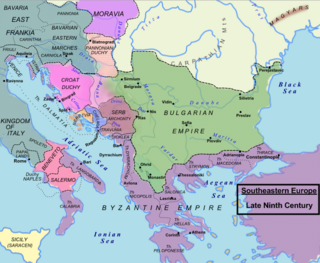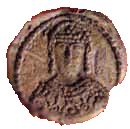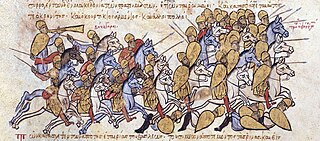 W
WThe First Bulgarian Empire was a medieval Bulgar-Slavic and later Bulgarian state that existed in Southeastern Europe between the 7th and 11th centuries AD. It was founded in 681 when Bulgar tribes led by Asparuh moved to the northeastern Balkans. There they secured Byzantine recognition of their right to settle south of the Danube by defeating – possibly with the help of local South Slavic tribes – the Byzantine army led by Constantine IV. At the height of its power, Bulgaria spread from the Danube Bend to the Black Sea and from the Dnieper River to the Adriatic Sea.
 W
WThe Battle of Achelous or Acheloos, also known as the Battle of Anchialus, took place on 20 August 917, on the Achelous River near the Bulgarian Black Sea coast, close to the fortress Tuthom between Bulgarian and Byzantine forces. The Bulgarians obtained a decisive victory which not only secured the previous successes of Simeon I, but made him de facto ruler of the whole Balkan Peninsula, excluding the well-protected Byzantine capital Constantinople and the Peloponnese.
 W
WBogomilism was a Christian neo-Gnostic or dualist sect founded in the First Bulgarian Empire by the priest Bogomil during the reign of Tsar Peter I in the 10th century. It most probably arose in what is today the region of Macedonia.
 W
WThe Bulgarian–Hungarian wars were a series of conflicts that occurred during the 9th–14th centuries between the Bulgarian Empire and the Kingdom of Hungary. The nearly 500-year conflict encompassed the northern and western Balkans, or what is known today as north-western Serbia, Romania and northern Bulgaria.
 W
WZaharija Pribislavljević or Zaharija of Serbia was Prince of the Serbs from 922 to 924. He defeated his cousin Pavle in 922. Zaharija was the son of Pribislav, the eldest son of Mutimir of the first Serbian dynasty.
 W
WIn 926 a battle was fought in the Bosnian highlands between the armies of the Bulgarian Empire, under the rule of Bulgarian Tsar Simeon I, who at the time also fought a war with the Byzantine Empire, and the Kingdom of Croatia under Tomislav, the first king of the Croatian state. The battle is also known as the Battle of the Bosnian Highlands. It was fought in the mountainous area of Eastern Bosnia near the rivers Bosna and Drina, the border area between the Kingdom of Croatia and the Bulgarian Empire.
 W
WThe Croatian–Bulgarian Wars were a series of conflicts that erupted three times during the 9th and 10th centuries between the medieval realms of Croatia and Bulgaria. During these wars, Croatia formed alliances with Eastern Francia and Byzantium against the Bulgarian Empire.
 W
WThe Battle of Dorostopol was fought in 971 between the Byzantine Empire and forces of Kievan Rus'. The Byzantines, led by John I Tzimisces, were victorious.
 W
WThe Battle of the Gates of Trajan was a battle between Byzantine and Bulgarian forces in the year 986.
 W
WThe Patleina Monastery of Saint Pantaleon is a ruined Bulgarian Orthodox monastery. It is an archaeological site situated at the outskirts of the capital of the First Bulgarian Empire, Preslav. At its heyday in the 9th and 10th centuries, the monastery was among the leading centres of the Preslav Literary School, as well as one of the most prominent centres of production of painted decorative ceramics.
 W
WThe Preslav Treasure was found in autumn of 1978 at the vineyard in Castana, 3 km to the north - west of the second Bulgarian capital – Veliki Preslav. The excavations that followed revealed more than 170 golden, silver and bronze objects including 15 silver Byzantine coins belonging to Constantine VII, Romanos II and other artifacts dating far back to the period between 3 rd and 7 th centuries.
 W
WRavna Monastery was a literary center of the Preslav Literary School during the 9th and 10th centuries in the north-eastern part of the Bulgarian Empire. It is located near the village of Ravna, at 11 km northwest of the town of Provadia, Varna Province, north-eastern Bulgaria. It was studied in the 1980s.
 W
WSamuil's Inscription represents the content found on the tombstone of Samuel of Bulgaria's parents, erected in 992/3. This inscription, which was made by the order of Tsar Samuel, mentions the names of his parents and of his brother David.
 W
WThe Battle of Spercheios took place in 997 AD, on the shores of the Spercheios river near the city of Lamia in central Greece. It was fought between a Bulgarian army led by Tsar Samuil, which in the previous year had penetrated south into Greece, and a Byzantine army under the command of general Nikephoros Ouranos. The Byzantine victory virtually destroyed the Bulgarian army, and ended its raids in the southern Balkans and Greece. The major historical source on the battle comes from Greek historian John Skylitzes whose Synopsis of Histories contains a biography of the then-reigning Byzantine Emperor, Basil II.
 W
WSviatoslav's invasion of Bulgaria refers to a conflict beginning in 967/968 and ending in 971, carried out in the eastern Balkans, and involving the Kievan Rus', Bulgaria, and the Byzantine Empire. The Byzantines encouraged the Rus' ruler Sviatoslav to attack Bulgaria, leading to the defeat of the Bulgarian forces and the occupation of the northern and north-eastern part of the country by the Rus' for the following two years. The allies then turned against each other, and the ensuing military confrontation ended with a Byzantine victory. The Rus' withdrew and eastern Bulgaria was incorporated into the Byzantine Empire.
 W
WThe Battle of Thessalonica occurred in 995 or earlier, near the city of Thessalonica, Greece. The battle was part of the long Bulgarian–Byzantine war of the late 10th and early 11th centuries. The Bulgarians under their ruler, Tsar Samuil, succeeded in ambushing and destroying the Byzantine garrison of Thessalonica, killing its commander, Gregory Taronites, and capturing his son Ashot.
 W
WThe Siege of Zadar in 998 was part of the third Croatian–Bulgarian war and one of the last military conflicts between Croatian forces of King Svetoslav Suronja, supported by Venice and the Byzantine Empire, and the army of Emperor Samuil, who launched a large-scale Bulgarian military campaign against the Kingdom of Croatia.